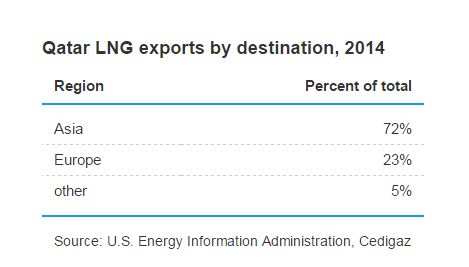A very interesting article by Foreign Affairs, about whether there will be an American-Russian price war over natural gas. See “A U.S. Gas War With Russia
In April 2016, the first shipment of American LNG arrived to Europe, and many analysts started talking about a price war between Russia Europe , since the American gas will reduce European dependency on Russian gas. Europe, together with Turkey, consume approximately 450 billion cubic meters of natural gas per year (2015), and Russia supplies approximately 1/3 of it, and earns 42 billion dollars (2015).
According to Foreign Affairs, the American LNG shipments to Europe will have a more ambiguous effect on Russia Europe a maximum of 80 billion cubic meters of LNG per year by 2020. But at the same time the European production is falling by 10 billion cubic meters per year i.e. Norway , Netherlands , England Europe , will only cover a part of the falling European production.
The Foreign Affairs article also mentions Norway and Algeria , who are the second and third largest suppliers of natural gas to Europe . The American LNG will reach the western coasts of Europe, and it will more likely hurt Norwegian and Algerian exports to Europe than the Russian ones. However nobody talks about a price war between American, Norwegian and Algerian natural gas, but they only talk about a price war between American and Russian natural gas.
Map
The Foreign Affairs article also mentions Qatar , because the European Union already had access to plenty of liquefied natural gas (LNG) from Qatar Qatar has significantly increased its exports of LNG to Europe during the last few years, and therefore the American shipments to Europe could hurt the Qatari LNG exports to Europe . Remember that the Qatari and Iranian state owned media passionately supported Bernie Sanders in United States
Moreover, the producers of natural gas in United States Japan , South Korea Japan , South Korea and Taiwan
Largest LNG Importers
In 2015 Japan was the third largest economy in the world, South Korea was the 11th largest, and Taiwan Japan in 2011 (Fukushima
These countries appreciate LNG more than the Europeans, because the European have access to pipeline networks from Russia, Algeria and Norway, and they might be willing to pay for the American LNG higher prices than the Europeans, and therefore nobody can say for sure how much of the 80 billion cubic meters of the American natural gas will reach Europe.
Also note that Qatar , Indonesia and Malaysia , all Muslim countries, are among the largest exporters of LNG, and they mainly export to Japan, South Korea , Taiwan , China and India Qatar is the largest LNG exporter in the world, and Malaysia Malaysia ’s financing of socialist propaganda in United States
Top LNG Exporters (2014)
Top LNG Exporters (2010)
Qatari LNG Exports
Indonesian LNG Exports
At the following map you can see the global natural gas market. With circles you can see the main country exports. The blue part refers to the exports by pipelines, and the green part to LNG exports. The bars show the country imports, and the blue parts refer to imports by pipelines, and the green parts to LNG imports. Some countries have both exports (circles) and imports (bars).
See also “The Map of Natural Gas”
and “The Map of War”
The Foreign Affairs also mentions Australia , which will significantly increase her LNG production in the next few years, and she will probably become the top LNG exporter in the world, and that’s more important for LNG prices than whether the American LNG will be sold to Europe or somewhere else. Note that Muslim oil and gas exporters who are threatened by the Australian production are financing socialists in Australia Australia has managed to defend the socialist propaganda and maintain a hard line towards immigrants who reach Australia through Indonesia Australia
Map Australia – Indonesia - Malaysia
I agree 100% per cent with the Foreign Affairs observations, and I do not think that the main thing of American LNG exports will be an American- Russian price war in Europe . The main war the Americans will have to fight will be domestically, because Iran , the Arabs and Russia will support American socialists, in order to use them as a fifth column in the United States
On the other hand the Russians will not be happy to see the American LNG arriving to Europe . It will be one more trouble for the Russians, even if it is not the main one.
Articles
“A U.S. Gas War With Russia
1st Paragraph
April 21, the first Europe-bound shipment of U.S. liquefied natural gas (LNG) left the Gulf of Mexico and crossed the Atlantic, a move that has been widely regarded as the first step in an impending gas war between the United States and Russia Russia Russia Europe wins, economically and geopolitically.
3rd Paragraph
By 2020, the United States could be sending roughly 80 billion cubic meters of LNG to Europe a year—about two-thirds of the volume that Russia exported to Europe in 2015 and just under a third of Europe’s entire gas consumption, which is 400 billion cubic meters per year (450 billion cubic meters, if one includes Turkey). It is no wonder that conflict seems imminent: if such a large share of U.S. LNG were to land in Europe, Russia would get pushed out of the market and lose a large chunk of the $42 billion it earned by exporting pipeline gas in 2015.
8th Paragraph
On the supply side, Norway is the second-largest provider of gas after Russia Algeria U.S. United States and Norway or Algeria U.S. LNG will compete in markets where Norway and Algeria are often larger players than Russia Algeria Europe will matter a great deal.
“Australia








Δεν υπάρχουν σχόλια:
Δημοσίευση σχολίου